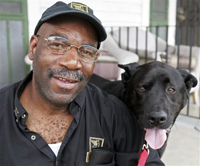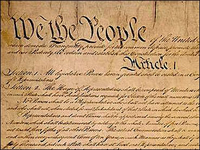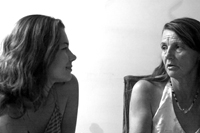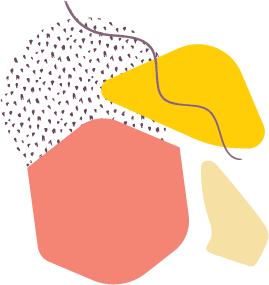The normalization of violence against women, relationship complexities and the pervasive cultural ideology that private matters should remain private have made domestic violence the number one cause of injury to women today – more than rape, muggings and automobile accidents COMBINED. With unprecedented access inside the California Institution for Women, SIN BY SILENCE offers a unique gateway into the lives of women who are domestic violence’s worst-case scenarios: women who have killed their abusers. Brenda Clubine endured broken bones. Skull fractures. Her face bruised and battered. By the time Brenda was put behind bars, for killing her husband in 1983, she felt worthless. She received a sentence of 15 years to life. She had to give up her son for adoption. She thought she was the only woman in her situation. But, Brenda soon discovered that she shared common experiences of love turning violent with many of her fellow inmates. After years of meeting on the yard and telling each other their whispered stories, an inmate-initiated and led group was born inside the prison in 1989, called Convicted Women Against Abuse (CWAA). Brenda’s revelation inspired this support group, the first group of its kind in the entire US prison system. The goal of the group is to help women inside prison break the silence about abuse and learn more about how they can help others stop the cycle of violence. Over the past 20 years, since the group was established, many familiar faces remain… LaVelma killed her husband, a pastor and pillar in the community. She never spoke a word to her family, or church members, that her husband beat her on a regular basis. She was embarrassed what others would think about what was happening behind closed doors. She had faith that her husband would change. Joanne tried to leave, but there were no options available to her. No shelters. No hotlines. No help from the police. Yet, she knew she couldn’t live in her car with two kids and temperatures dropping. So, she continued to go back and the abuse for her, and her kids, got worse. Glenda ran over her husband with her car in a public parking lot. He died at the scene. A cut and dry murder case. Yet, why would a 45-year-old woman with no prior criminal history brutally kill her husband? Instead of fighting a system that does not fully comprehend the complexities of abuse, CWAA led an initiative to help educate the system. Through careful orchestration of letter writing campaigns, media coverage, and senate hearings, a movement was born and laws were changed. And, finally, for Brenda Clubine the flicker of hope begins to grow that her freedom from prison lies moments away. Like many of the CWAA women, Brenda’s years of inflicted abuse were never fully revealed in her trial since, prior to 1992, California law did not allow a legal defense to include evidence of battering. But because of CWAA’s advocacy, new laws were set in place in 1992 and 2002 that allow incarcerated survivors to utilize the defense of Battered Women’s Syndrome and even challenge their original conviction. Because of those efforts, battered women across the country are currently receiving lesser sentences and are now permitted to seek a new trail if they were convicted before the laws recognized the importance of expert testimony on the effects of battering. After 26 years in prison, on October 22, 2008, Brenda became the 20th CWAA member to gain her freedom. A chance to walk on the beach. A chance to be with her son who she was told had died by his adoptive parents just after her incarceration. A chance to continue her advocacy and be a voice for the women of CWAA in the free world. Every other Monday for over eight years, the director of SIN BY SILENCE, Olivia Klaus, attended CWAA meetings and built incredibly close relationships with each of the women, carefully capturing their stories for the documentary. Through their stories of terror and hope, the viewer can begin to understand the cycle of violence, the signs of an abuser, and how each and every one of us is responsible for changing the tragedy of domestic violence.
Summary info for schedule – will be hidden on film page
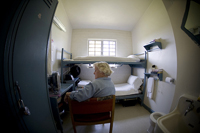
Sin by Silence
49-minutes
Screening day / time
Sin by Silence
Sin by Silence
Filmmaker Notes:
My world was shattered by a three-minute phone call. I had always heard about domestic violence, but it was a problem that happened to other people. Yet there it was…on the other end of the phone. A close friend of mine was a victim. As my mind started racing for ways to help or fix things, I realized, to my horror, that I was completely helpless. I had no answers, no solutions. I held that phone in silence as I heard the dark secrets of a seemingly perfect marriage unravel. My painstaking journey continued, as I watched my friend move towards gaining the courage to leave her husband of eight years. Numerous lawyers. New address. New phone number. I agonized as she kept going back, and I knew there had to be more ways to understand what she was going through and how I could help. I started discovering women’s shelters and organizations. Yet, they offered extremely limited resources for victims and those trying to help. Then a conversation with a colleague, Dr. Elizabeth Leonard – author of Convicted Survivors – changed everything. She started talking about her own inspiration for solutions to the crisis at hand. She suggested that my quest include a trip to the most unlikely place – prison! The first time I visited the California Institution for Women was in 2001. I was nervous that evening, wondering whom I was about to meet. The group Convicted Women Against Abuse (CWAA) was comprised of women who had killed the men they once loved. But when the meeting started, I was slowly introduced to women who could be my neighbors, my friends, my sister…or even myself. Since that first meeting, I have been unable to turn my back on the women of CWAA. They, along with my friend, opened my eyes to a part of the world that I never knew existed. Once that silence had been broken, I found that I could never pretend that life was the way it was before. Through CWAA meetings, I slowly realized that these women were the experts on domestic violence and were willing to share stories of how they found themselves on such dark and desperate paths. And, as relationships were built, the women soon found out that my background was filmmaking and approached me to help tell their stories. I knew with this request came a long journey, yet I knew their voices must be heard. So, what began as a dedication to help one woman, mobilized into an effort to help many. Filming didn’t just happen overnight. There were approvals from the California Department of Corrections, the Governor’s office, the warden of the California Institution for Women. Yet, I had been attending CWAA in the prison for over a year already as a volunteer for the CWAA groups, so something that could take a media crew up to six months to gain approval happen for me in one month’s time. I was already an ‘employee’ in the eyes of the officials and employees at CIW. They knew my heart and knew my passion for these womeMonth after month, year after year, I drove the 70 miles to be at every CWAA meeting. I listened to experiences that were living nightmares. I began trying to raise funds. The women of CWAA believed that they could be a part of impacting the “outside” world and gave the first $1000 – a donation made up from average wages of only 10 cents an hour.We began the process of filming countless CWAA meetings under the horrible production conditions of prison and state schedules. By participating and listening in on these interactions, we documented several women’s epic stories as they began to discover hope and dignity. Many interviewees openly expressed gratitude for the freedom to tell “the whole story” to someone with whom they felt comfortable. A surprisingly large proportion of the women stated that this was their first opportunity to openly reveal their lives, their abuse, their experiences, and their perceptions. The women of CWAA became stronger as a result of the filming process. Many members who used to remain in the background started to find their voice and members started inviting other inmates they met on the yard. An entirely new sense of purpose was given to the women of CWAA and a sense of empowerment came from finally being able to have their voices be heard. An empowerment that could lead to other women learning how to not follow in their footsteps. Empowerment that could push society to finally do something about the countless women being brutalized behind closed doors. It has now been eight heart-wrenching years since my first visit to prison. My initial introduction to this tragedy still remains an unresolved saga; my friend has gone back to her husband countless times, and I don’t expect that cycle to change anytime soon. But because of her story, and the women of CWAA, I realize how crucial the information is in SIN BY SILENCE. If abused women can hear the ring of truth from these women’s stories and understand their own choices, their lives will change, their roles will transform, and the next generation will be different.
